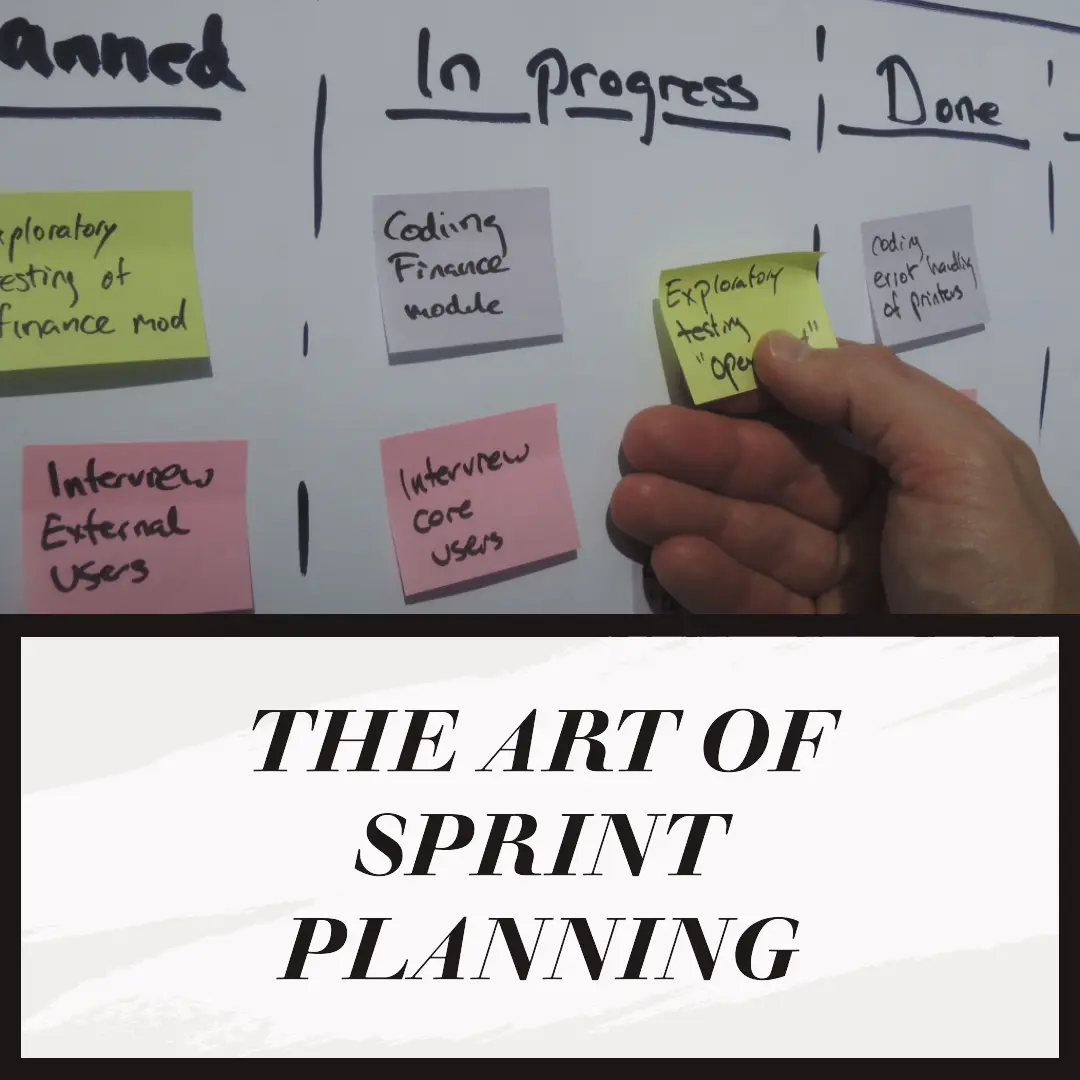To find out how Artificial Intelligence is changing the Project Management landscape, you may enjoy reading this article https://www.shaunstoltz.com/did-artificial-intelligence-just-change-everything-about-project-management/
I. Introduction
Welcome to the dynamic world of Agile Project Management, where adaptability meets productivity in the most innovative way. If you’re a project manager, a software developer, or anyone who is part of a team that works under the Agile umbrella, you’ve landed in the right place.
In the Agile realm, Sprint Planning holds a pivotal role, functioning as the cornerstone that ensures the team’s efficiency and the project’s successful progression. Misunderstood by some, underutilized by others, the Sprint Planning process can seem daunting to those unfamiliar with its intricacies. Yet, when properly understood and effectively executed, it can unlock incredible potential within your team, paving the way for success.
In this comprehensive guide, we will demystify Sprint Planning. We’ll delve deep into its core elements, revealing its inherent power as a tool for streamlining tasks, promoting team collaboration, and driving project advancement. From the essential concept of a ‘Sprint’ to the step-by-step guide of Sprint Planning, we aim to equip you with the knowledge and tools you need to elevate your team’s performance and optimize project outcomes.
So, whether you’re new to the Agile methodology or an experienced practitioner looking to refine your Sprint Planning strategy, this guide is designed to offer valuable insights that can be applied to your next project. Let’s dive in and explore the art of Sprint Planning!
II. The Concept of a Sprint
Before we explore the ins and outs of Sprint Planning, it’s essential to understand the fundamental concept of a ‘Sprint.’ In the Agile methodology, a Sprint is akin to a heartbeat – it’s the regular, rhythmic pulse that drives the project forward.
A. Definition and Purpose of a Sprint
A Sprint is a predefined, time-boxed period during which a specific set of tasks is completed. Sprints are at the core of Agile project management, allowing teams to break large, complex projects into manageable, bite-sized pieces. The primary purpose of a Sprint is to deliver increments of potentially releasable functionality, reducing the time between an idea’s inception and its implementation.
B. Typical Duration and Participants
Sprint durations can vary depending on the project and the team, but they typically last between one to four weeks. The length of a Sprint is determined at the start of the project and remains consistent throughout its lifecycle. This consistency allows teams to predict their work capacity and plan accordingly.
The participants in a Sprint are the Scrum Team, which consists of the Product Owner, the Scrum Master, and the Development Team. Each role brings unique skills and perspectives to the table, ensuring a balanced and effective approach to accomplishing the Sprint’s objectives.
C. Sprint Goals
Every Sprint revolves around a Sprint Goal – a clear, concise statement of what the team plans to achieve during the Sprint. The Sprint Goal provides a shared objective, aligns the team, and serves as a guide when making decisions about what work should be prioritized. It’s the beacon that guides the team through the fog of tasks and requirements.
Now that we’ve laid the groundwork with a solid understanding of what a Sprint is, let’s move on to the actual art of planning these critical periods. Buckle up as we delve deeper into the role of Sprint Planning in our next section.
III. The Role of Sprint Planning
Sprint Planning is a lighthouse guiding the Agile team’s journey through the sea of project tasks. It sets the course for each Sprint, providing a clear vision of the objectives and the path to their accomplishment.
A. Definition of Sprint Planning
Sprint Planning is a collaborative meeting where the Scrum team determines what they can commit to completing during the upcoming Sprint. It involves examining the Product Backlog, identifying priority items, and mapping out a plan of action. The result of Sprint Planning is a clear and agreed-upon Sprint Backlog, accompanied by a Sprint Goal.
B. Benefits of Effective Sprint Planning
The benefits of effective Sprint Planning are multifold. It provides a structured framework for the team to understand the project’s current state, set realistic goals for the upcoming Sprint, and create a roadmap to achieve them.
Effective Sprint Planning can:
- Foster better team communication and collaboration.
- Minimize risks by proactively identifying and addressing potential issues.
- Enhance productivity by clearly defining the scope of work.
- Improve predictability and control over the project progress.
C. The Role of the Scrum Master, Product Owner, and Development Team in Sprint Planning
Every participant in a Sprint Planning meeting plays a unique and essential role:
- The Scrum Master: Facilitates the Sprint Planning meeting, ensuring that the team reaches a consensus on the Sprint Goal and the Sprint Backlog. They help the team to stay focused, encourage effective communication, and ensure that the meeting adheres to the time-box.
- The Product Owner: Provides clarity on the Product Backlog items and their priority. Their main role is to communicate the product vision and business goals to the team, helping them understand the ‘why’ behind the work.
- The Development Team: Forecasts the amount of work they can commit to during the Sprint. They actively participate in the discussion, ask questions, clarify doubts, and eventually, commit to the Sprint Backlog.
With a solid grasp of the role and benefits of Sprint Planning, we’re ready to dive into the meat of our guide – a step-by-step walkthrough of the Sprint Planning process. So, let’s get started!
IV. Step-by-Step Guide to Sprint Planning
Mastering Sprint Planning is an art that can significantly enhance your team’s productivity and project outcomes. It’s not just about assigning tasks; it’s about fostering collaboration, enabling transparency, and steering the team towards achieving the Sprint Goal. Let’s break down the process step by step:
A. Pre-planning: Backlog Refinement
While not officially part of Sprint Planning, Backlog Refinement (or grooming) sets the stage for a successful planning session. During this process, the Product Owner and the Development Team review and revise the Product Backlog, ensuring that the highest-priority items are well-defined and ready for selection in the next Sprint.
B. Step 1: Setting the Sprint Goal
The Sprint Planning meeting kicks off with the Product Owner proposing a Sprint Goal. This goal is a high-level summary of what the team should aim to achieve by the end of the Sprint. It provides direction and focus, enabling the team to make decisions that align with the project’s broader objectives.
C. Step 2: Selecting Backlog Items for the Sprint
Next, the team collaboratively decides which Product Backlog Items (PBIs) will be tackled in the upcoming Sprint. The Product Owner presents the top-priority PBIs, and the Development Team, considering their capacity, selects the tasks they believe they can complete within the Sprint.
D. Step 3: Decomposition of Backlog Items into Tasks
Once the PBIs for the Sprint are chosen, the team breaks them down into smaller, manageable tasks. This decomposition helps the team understand the work better, estimate it more accurately, and distribute it effectively among team members.
E. Step 4: Estimation of Tasks
The team then estimates the effort required for each task. Various techniques can be used for estimation, such as Planning Poker, T-shirt sizing, or the bucket system. The goal is to create a shared understanding of the work involved and to ensure that the team doesn’t overcommit.
F. Step 5: Commitment to the Sprint Backlog
Finally, based on the task estimations, the team commits to the Sprint Backlog — the set of tasks they plan to complete during the Sprint. It’s crucial that this commitment is genuine and realistic, fostering a sense of ownership and responsibility among team members.
Remember, Sprint Planning is not a one-size-fits-all process. You may need to adapt these steps to suit your team’s needs and project context. The ultimate goal is to create a clear roadmap for the upcoming Sprint, empowering your team to work efficiently towards achieving the Sprint Goal.
With this step-by-step guide, you’re now equipped to navigate the intricacies of Sprint Planning. In our next section, we’ll tackle common challenges and offer solutions to ensure smooth sailing. Stay tuned!
V. Common Challenges in Sprint Planning and How to Overcome Them
Even with a clear understanding of the process, Sprint Planning can present certain challenges. Let’s shine a light on some common pitfalls and provide strategies to navigate them effectively:
A. Miscommunication Among Team Members
Challenge: Communication gaps can lead to misunderstandings about task requirements or team members’ roles, resulting in ineffective planning and execution.
Solution: Foster a culture of open communication. Encourage team members to ask questions, share ideas, and voice concerns during the Sprint Planning meeting. Utilize collaborative tools that allow everyone to view and update the Sprint Backlog in real-time.
B. Over or Underestimating the Capacity of the Team
Challenge: Overestimating can lead to stress, burnout, and incomplete tasks, while underestimating can result in wasted capacity and slower progress.
Solution: Regularly review and update your team’s capacity based on historical performance data (velocity) and any known changes, like vacations or training days. Remember that capacity is not just about the hours available, but also the complexity and unfamiliarity of tasks.
C. Handling Changes During the Sprint
Challenge: Unforeseen issues or changes in business priorities can disrupt the Sprint Backlog, causing confusion and delays.
Solution: Embrace agility. While the Sprint Backlog should remain largely stable, it’s important to be flexible and adapt when necessary. If a change is needed, discuss it with the team, assess the impact, and adjust the plan collaboratively.
D. Ensuring Complete Team Involvement
Challenge: If some team members are not fully engaged in the Sprint Planning process, they might lack commitment to the tasks or feel disconnected from the Sprint Goal.
Solution: Ensure everyone’s input is valued during Sprint Planning. Foster a sense of ownership by allowing team members to choose their tasks. Regularly reinforce the Sprint Goal and how each person’s work contributes to it.
Remember, challenges are opportunities for growth. By acknowledging these potential hurdles upfront and implementing these strategies, you can turn Sprint Planning from a stumbling block into a stepping stone towards project success.
As we move forward, let’s explore some tools and techniques that can further enhance your Sprint Planning process. Onward we go!
VI. Tools and Techniques for Effective Sprint Planning
In the digital age, we’re fortunate to have a wealth of tools and techniques at our disposal to streamline and enhance the Sprint Planning process. By integrating these into your workflow, you can improve communication, task tracking, and overall project management efficiency.
A. Explanation of Common Tools Used
JIRA: A highly popular tool among Agile teams, JIRA facilitates project tracking, issue tracking, and agile planning. It allows teams to create and estimate stories, build a sprint backlog, visualize activity, and report on their team’s progress.
Trello: Known for its simplicity and flexibility, Trello uses a card-based system that makes it easy to organize tasks and track progress. It’s excellent for managing Sprint Backlog and offers visual cues for task status.
Asana: Asana is a comprehensive project management tool that supports Sprint Planning by allowing teams to create tasks, assign them to team members, set deadlines, and track progress.
B. Techniques for Effective Communication and Task Tracking
Daily Stand-ups: A short, daily meeting where team members sync up on their progress and discuss any blockers. It promotes transparency and swift problem resolution.
Planning Poker: A gamified estimation technique that promotes team consensus on task complexity. Each team member “bets” on how much effort a task will require, leading to discussion and eventual agreement.
Retrospectives: A review meeting held at the end of each Sprint where the team reflects on what went well and what could be improved. It’s a powerful tool for continuous improvement.
Visual Management (Kanban boards, Burn-down charts): Visual tools that provide a snapshot of project progress. They help teams understand the work distribution, track progress, and identify bottlenecks.
Implementing the right tools and techniques can make your Sprint Planning more efficient and effective. However, remember that they are aids to enhance your process, not substitutes for good planning and communication.
In the next section, we’ll bring everything we’ve discussed so far to life with a real-world case study. Stay tuned!
VII. Case Study: Sprint Planning Success
To truly appreciate the transformative power of effective Sprint Planning, it’s valuable to consider a real-world example. Let’s explore how the tech startup ‘InnovateX’ turned their project around with a refined approach to Sprint Planning.
A. Background
InnovateX, a budding tech startup, was developing a cutting-edge mobile app. However, their development process was in turmoil, marked by frequent missed deadlines, low productivity, and team burnout. Upon review, it became clear that their issues stemmed from ineffective Sprint Planning. Tasks were poorly defined, overcommitment was the norm, and the Sprint Goal was often overlooked.
B. The Shift to Effective Sprint Planning
Recognizing the need for change, InnovateX decided to redefine their Sprint Planning process. They started with backlog refinement, ensuring tasks were clear and prioritized before planning. Sprint Goals were set to provide clear direction, and team capacity was accurately assessed to prevent overcommitment.
InnovateX also incorporated the use of JIRA for task tracking and Planning Poker for task estimation, promoting transparency and consensus within the team. Daily stand-ups were implemented to maintain team alignment and swiftly address any roadblocks.
C. The Outcome
The transformation was remarkable. With effective Sprint Planning, InnovateX saw a substantial improvement in their project outcomes. Tasks were completed within the Sprint, the quality of work improved, and the team felt less stressed and more engaged. Most importantly, they were now reliably delivering value to their stakeholders with each Sprint.
This case study exemplifies how effective Sprint Planning can not only streamline the development process but also enhance team morale and project outcomes. It’s a testament to the fact that investing time and effort in Sprint Planning can truly pay off.
In our final section, we’ll recap the key takeaways from this guide and leave you with some parting thoughts to carry into your next Sprint Planning session. Let’s forge ahead!
VIII. Wrapping Up: Key Takeaways
As we conclude our journey through the Art of Sprint Planning, let’s pause to reflect on the key insights we’ve gathered:
- Understanding the Sprint: A Sprint is a time-boxed period in Agile project management where specific tasks are completed. It forms the heartbeat of an Agile project, driving it forward with regular pulses of progress.
- The Role of Sprint Planning: Sprint Planning is a collaborative meeting where the team decides what they can commit to in the upcoming Sprint. It’s the lighthouse that guides the team through the sea of tasks.
- The Sprint Planning Process: Sprint Planning involves setting the Sprint Goal, selecting Backlog items, decomposing these items into tasks, estimating these tasks, and committing to the Sprint Backlog. It’s an art that requires practice and fine-tuning.
- Overcoming Challenges: Common challenges in Sprint Planning include communication issues, misestimation of capacity, handling changes, and ensuring team involvement. By acknowledging these upfront and applying effective strategies, you can turn these challenges into opportunities for growth.
- Tools and Techniques: Tools like JIRA, Trello, and Asana can enhance your Sprint Planning process. Techniques such as Daily Stand-ups, Planning Poker, Retrospectives, and visual management can boost communication and task tracking.
- Real-world Impact: As our case study showed, effective Sprint Planning can transform project outcomes. It streamlines the process, improves productivity, and enhances team morale.
Sprint Planning is not just a process; it’s a powerful strategy that, when executed effectively, can catalyze your team’s productivity and project success. Remember that the key to effective Sprint Planning lies in its core principles: collaboration, transparency, and commitment. As you embark on your next Sprint Planning session, bear these insights in mind, and watch your team navigate the path to success with newfound clarity and confidence.
Thank you for joining us on this exploration of the Art of Sprint Planning. We hope you found it enlightening and actionable. Here’s to your project’s success and your team’s continual growth!
Find out more about Shaun Stoltz https://www.shaunstoltz.com/about/
This post was written by an AI and reviewed/edited by a human.



